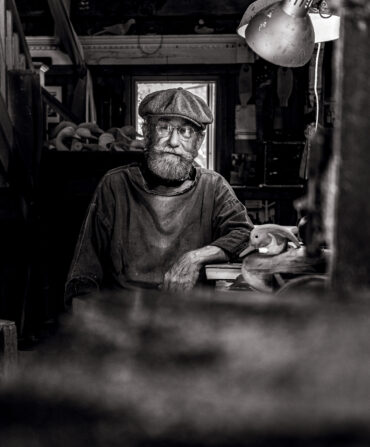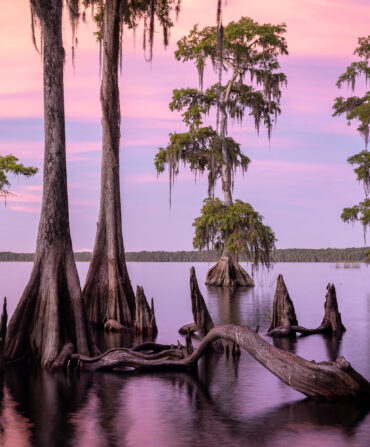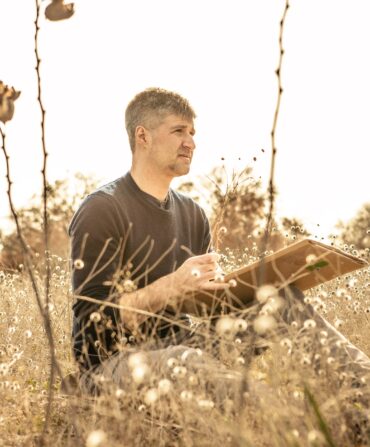Land & Conservation
Currituck Defenders
Long a duck-hunting mecca, North Carolina’s Pine Island stands as one of the few remnants of the untamed Outer Banks. Today, thanks to the National Audubon Society, it’s also a living laboratory for how to protect the coastal South’s uncertain future

Photo: Peter Frank Edwards
Geese fly over a blind at Pine Island Sanctuary; Guide and decoy carver Chandler Sawyer.
The teal sweep in from the south, green-wings low over the decoys after we’d been barking at flocks of black ducks and gadwalls all morning. An hour earlier, Chandler Sawyer told me that of all the ducks teal were his favorite, and now this trio buzzes two feet off the water, wing tips nearly brushing the hand-carved gaddies and wigeon and ruddy ducks in front of the blind.
“What the…!” Sawyer exclaims, with no time to finish the query, and we both scrunch low in the blind, hands on shotguns, as Sawyer, a guide and decoy carver, peeps at the teal arrowing across the Currituck Sound salt marsh, an opportunity squandered.
Except you can’t give up on teal—you never give up on teal—and now the birds bank to the left, green flashing on their wing patches, and when I see white bellies, the guns come up and there’s no need for Sawyer to call the shot because teal give you half a chance if any chance at all and we pull triggers at very nearly the same moment.
We watch Sawyer’s brawny Chesapeake Bay retriever, Chief, retrieve the birds, and as I hold two drakes in my hands, their symbolism seems as clear as the green iridescence on their wings. Here, at Pine Island Sanctuary, in the far northeastern corner of North Carolina, these ducks are a testament to decades of hard work and effort and planning. After all, it is no accident that ducks are here in the first place, and that this historic, story-rich marsh still exists, when so much of the wild Currituck Sound has vanished.

Photo: Peter Frank Edwards
Chief watches the hunt intently.
Currituck Sound is an oblong Rorschach blot of open shallows, salt marsh, maritime forest, and coastal sand dune. Top to bottom, it is roughly forty miles in extent, reaching north into Virginia’s Back Bay. Pine Island itself is very nearly smack in the middle, sandwiched between Duck and Corolla. It isn’t an island in the typical sense, but a hump of relatively high ground on the larger barrier island that forms this part of the Carolina coast, just under three thousand acres that have remained intact despite the onslaught of coastal development that has transformed most of the famed northern Outer Banks.
Few landscapes in the South recall a heritage of waterfowling as does Currituck Sound. In the nineteenth and early twentieth centuries, duck-hunting clubs controlled vast swaths of Currituck. Built and governed largely by wealthy Northern industrialists, the clubs employed caretakers and cooks, guides and marsh guards. The largest were opulent manses, including the 21,000-square-foot 1920s art nouveau Whalehead Club. Perhaps a dozen such clubs operated here, and the Pine Island Club was one of the last to remain in private hands.
It’s also one of the few with a direct, living connection to the history of those waterfowling clubs. Chandler Sawyer is an eleventh-generation Currituckian, the latest in a line of duck guides and decoy carvers who still ply the marshes and turn chunks of juniper into wigeon and curlews. His family once owned all of Pine Island and far beyond. He lives in a world where the past deeply informs the present, and where the future is rife with challenge.

Photo: Peter Frank Edwards
Sawyer works a call.
And with opportunity, as Pine Island is remarkable in at least one additional regard: The entire property is owned by the National Audubon Society. Its official name is the Donal C. O’Brien, Jr. Sanctuary and Audubon Center at Pine Island, named for the former National Audubon Society chairman (he served for five decades as the Rockefeller family attorney) who hunted with the last owners, the Earl Slick family. Slick donated the property to Audubon in 1978, with stipulations that his family could remain and hunt the club until December 31, 2009, when Audubon assumed full management of one of the most unspoiled barrier island complexes and critical waterfowl habitats on the Atlantic coast.

Photo: Peter Frank Edwards
Chief awaits the morning’s hunt.
Now Audubon is tasked with a daunting set of initiatives: Shepherd an imperiled natural treasure and a hallowed piece of waterfowling history. Confront epic, confounding issues of climate change and sea-level rise. Complete a massive renovation to convert a raft of structures, including the 1913 lodge, a slate-roofed guide cabin, a kennel, and an old duck-plucking house—all of which sit a mere four feet above current sea level—into a modern research and program campus. Archive documents and artifacts and preserve the club’s venerable hunting traditions. Invite the public to experience Pine Island and the lessons it holds through self-guided hikes as well as guided nature programs, kayak tours, and educational outreach. And balance all of the above in ways that don’t fray the sanctuary’s fragile ecology.
That’s a lot to ask of a few square miles of marsh and water and dunes. You can’t grasp it all from one place. So perhaps it’s best to start with the past.
Chandler Sawyer is thirty-seven years old, tall and lean, with hands hard and burnished by the carving tools he wields to produce duck and shorebird decoys. He was raised fishing and hunting and guiding on Currituck Sound. After college he worked for the state’s marine fisheries department, tagging striped bass. When he got a call from Audubon to consider coming to Pine Island Sanctuary as habitat manager, “it was kind of unbelievable,” he says. Part of his job is guiding hunters on lands that were in his family centuries ago. Hunting on the property is allowed on a limited basis, by invitation only. But he also carries the burden of history keeper, and the task of relaying Pine Island’s waterfowling heritage to the Sanctuary’s growing number of visitors—hunting and nonhunting alike—falls largely on his shoulders. If he feels the pressure, it doesn’t show. It seems as if he’s been preparing for this role forever. Or at least three hundred years.
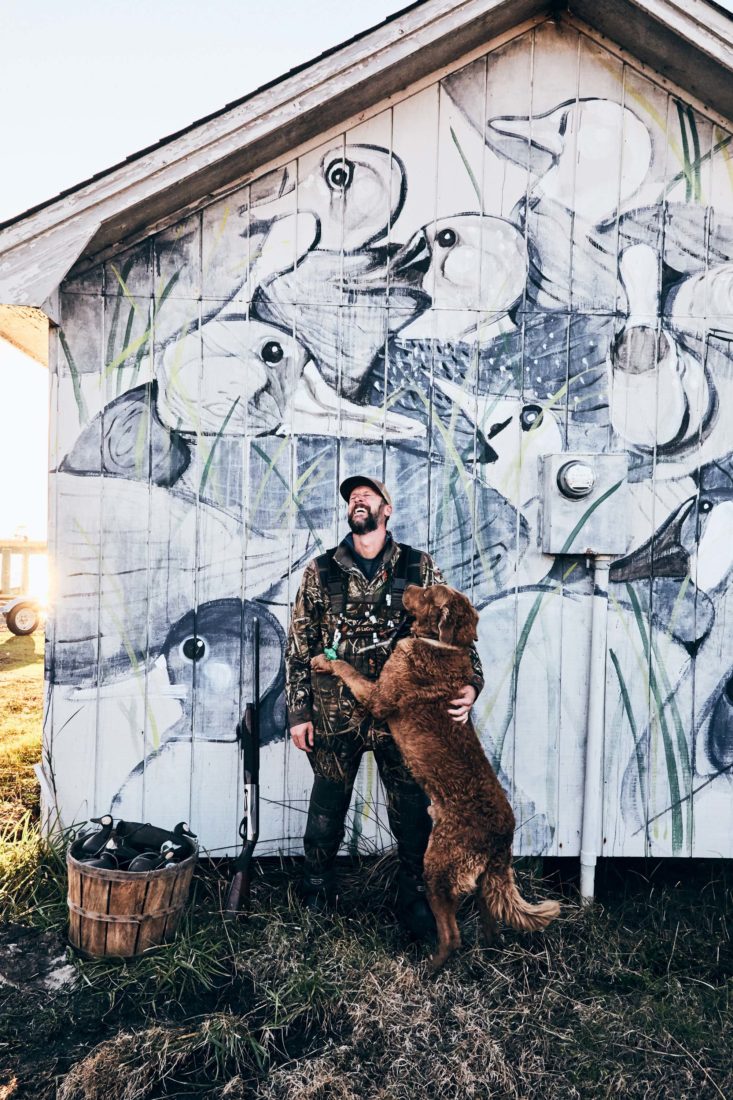
Photo: Peter Frank Edwards
Sawyer and Chief in front of the Sanctuary’s kayak boathouse.
Sawyer’s ancestor Abraham Baum was deeded this property in 1714, through an original land grant from the English crown. At the time the family holdings sprawled more than ten miles, from sound to sea. “I guess my family were the first New World owners of this place,” Sawyer says, with a nod toward the sweep of human history here that long predated the arrival of Europeans. “They were fishermen and farmers and hunting guides and market hunters. Whatever it took to sustain life out here. And it was like that as late as my grandfather’s day. I remember him saying, ‘Farm, fish, hunt, or get out.’ Those were your choices.”
In 1856, Baum’s descendants sold 3,100 acres at one dollar an acre to investors who started the famed Currituck Shooting Club. It is still in operation, the oldest private hunting club on the East Coast. Others soon followed, and over the years, Baum family descendants wound themselves into the story of the region’s wealthy waterfowling estates. Sawyer’s great-grandfather went to law school and ultimately served as an attorney for many of the Currituck’s duck properties. The family sold the last of their lands in 1910 to Massachusetts hunters, who formed the Pine Island Club.
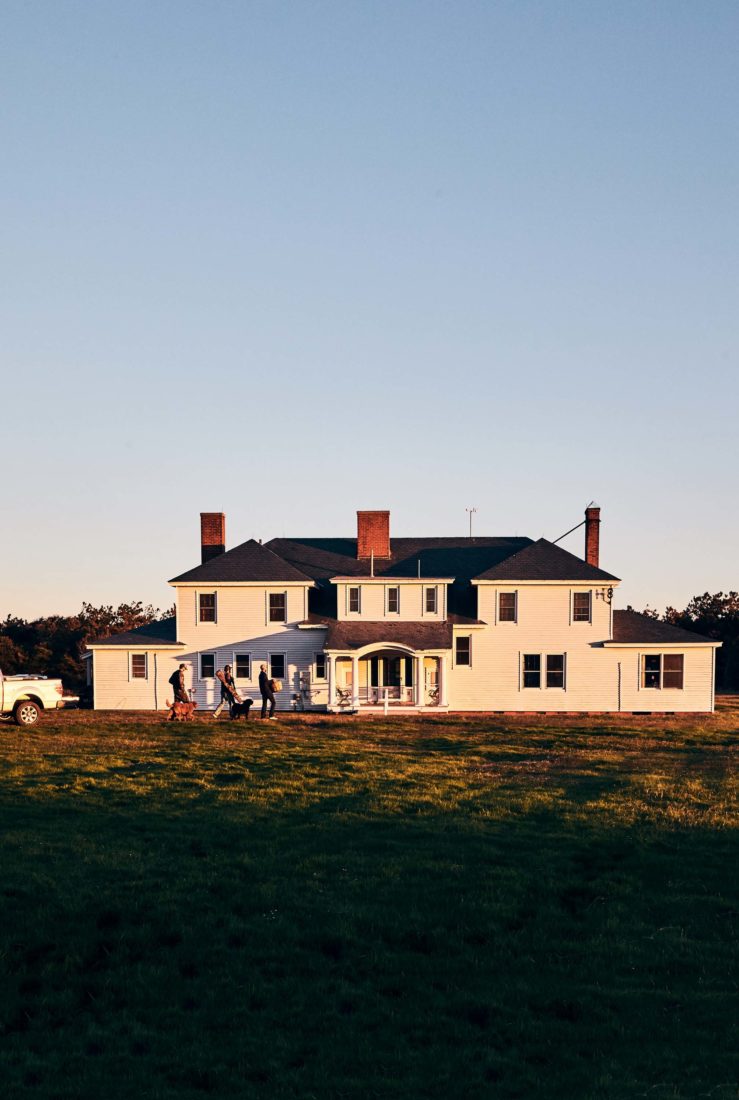
Photo: Peter Frank Edwards
The 1913 Pine Island Club lodge.
“The Northern owners didn’t want locals out here,” Sawyer says, sitting in the open sunlight of the Sanctuary’s boathouse. He has folded his lanky frame into a low-slung beach chair in the sunny opening of the boathouse doors. He wears a green hoodie and blue jeans half tucked into short rubber boots. He looks out over the marsh creek—Baum Creek—his blue eyes catching the pewter-gray waters. “For generations we were shut out of lands that we had owned for so long. It wasn’t until Audubon bought this property and hired me that the family line came back. It feels like I’ve come full circle.” Which seems appropriate, for Pine Island Sanctuary is charged with looking forward as much as looking back.
One afternoon I take a sprawling tour of the island with Greg Andeck, who directs conservation strategy and government relations for Audubon North Carolina, the state office of the National Audubon Society, and Robbie Fearn, Pine Island Sanctuary’s director. We wade through cloistered meadows speckled with wildflowers and under soaring live oaks, the maritime forest understory a riot of blueberry and bay shrubs. It’s a stunning example of the largely lost beauty that was once found between coastal dunes and upland forests, now subsumed by vacation homes across much of the South’s Atlantic coast. But what Andeck and Fearn really want me to see is a place fraught with future challenge, a shoreline sinking into the water.

Photo: Peter Frank Edwards
Robbie Fearn, Pine Island Sanctuary’s director.
We burst out of the deep shade of a scrub-shrub woodland onto a shoreline of forest giving way to Currituck Sound. The marsh edge is corroded and crumbling. Trees stand with dead bleached trunks. “In just three years the shore here has eroded about six to eight feet,” Fearn says, shaking his head. “It’s quite dramatic.” Sea-level rise and stronger storm events due to climate change, Andeck says, combined with less sand moving into the sound as a result of coastal development, are accelerating erosion rates throughout Currituck Sound.
This loss of marsh and high ground is of primary concern for bird conservation. One-hundred eighty-one bird species have been tallied on the island, seventy-nine of which are on Audubon’s list of birds threatened or endangered by climate change. “And it’s not just waterfowl,” Fearn explains, but also forest songbirds such as prairie warblers and painted buntings. During migration, young first- and second-year birds aren’t confident enough to fly over the ocean, he says, “so they hop from coastal forest to coast-
al forest. Since Audubon is in the business of making baby birds, this place is critical.”

Photo: Peter Frank Edwards
Tundra swans.
Audubon at Pine Island also serves as a laboratory for how the Southern coast will fare with sea-level rise. Andeck points to a half-rotten wooden barrier five feet out in the water. “Those bulkheads are an old-school way of dealing with erosion,” he explains. “The result is simply water hitting a wall, and that’s no good for birds, marine life, or human populations. Everybody loses. So we’re removing bulkheads and changing them to living natural shorelines to give these islands resilience and ramp up their value to wildlife.”
Working with university scientists and other researchers, Audubon is developing a marsh restoration plan using a range of techniques, from adding sediment to existing marshes to reestablishing submerged aquatic vegetation to building “fetch break” islands that absorb wave energy and provide important habitat for birds and ducks. Approaches pioneered at Pine Island will be used up and down the Atlantic Flyway. “We want to conserve the places where the birds need to be today and a hundred years from today,” Andeck says, “so we’re being very intentional that what we do here can be replicated across our entire coast.”
That intentionality is evident in the Sanctuary’s master plan. While the marshes are being studied and probed and measured and restored, and old club structures are being retrofitted for use as laboratory space and quarters for visiting scientists and educational groups, all the buildings—including the historic lodge—will be raised about seven feet and connected via boardwalks over what will one day be tidal marsh. Forest edges will be managed to facilitate marsh migration upslope, and existing turf fields planted in native wildflowers and grasses that benefit wildlife.

Photo: Peter Frank Edwards
Picking up the decoys.
“We will make these facilities operate in a dynamic system,” Andeck says. “We can no longer just plop a building down without thinking about the broader environment in which it operates. We’re taking a fresh approach to living in concert with nature.
“The threats have changed,” he says. “The issues of market hunting and unchecked exploitation have been solved, but now we’re faced with even greater challenges: pollution, development, sea-level rise. And we proactively engage the local community in this work because without all that history and heritage, this place loses much of its meaning.”
In the lodge’s great room, where a smoke-stained fireplace mantel holds pintail and coot decoys and the late-afternoon light slants across old volumes of waterfowling and Currituck Sound history, the Audubon Society’s long presence in Currituck, and at the forefront of the American conservation ethic, is close at hand.

Photo: Peter Frank Edwards
Antique Canada goose decoys from Currituck County.
In the late nineteenth and early twentieth centuries, market gunning for waterfowl was nearly matched in intensity by the trade for bird feathers, wings, and entire bodies as decoration for ladies’ hats. So-called “plume hunters” ravaged breeding colonies of terns, gulls, herons, and egrets. In 1903, one ornithologist estimated that only a dozen least tern eggs were laid on the entire North Carolina coast, where fifteen years earlier a half million individuals summered on the state’s beaches.
Currituck hunters, whether gunning for gulls or game, were widely known for their deadly skill. “Shooting wild fowl is a business with them, and they practice every lure, endure every hardship, and generally violate every law to obtain the game,” wrote Alexander Hunter in The Huntsman in the South, describing Currituck County market hunters circa 1908. The county was “the bloodiest slaughter-pen for waterfowl that exists anywhere on the Atlantic Coast,” wrote William Temple Hornaday, an ardent hunter, conservationist, and the first director of the New York Zoological Society, today known as the Bronx Zoo.
The slaughter of ducks for the table and other birds for the fashion trade spawned the National Audubon Society, some of whose state chapters took a hands-on approach to patrolling shores. In 1903 North Carolina passed the Audubon Act, making it unlawful to kill any wild bird other than a game bird and various nuisance birds. The Audubon Society of North Carolina was given authority to sell out-of-state hunting licenses to pay for its own bird and game wardens to act on behalf of the state. It was, according to one observer, “the first law ever enacted in any South Atlantic or Gulf state to provide for a game-warden system.” In its first year the Audubon Society fielded twenty-nine wardens, with four stationed in Currituck County alone.
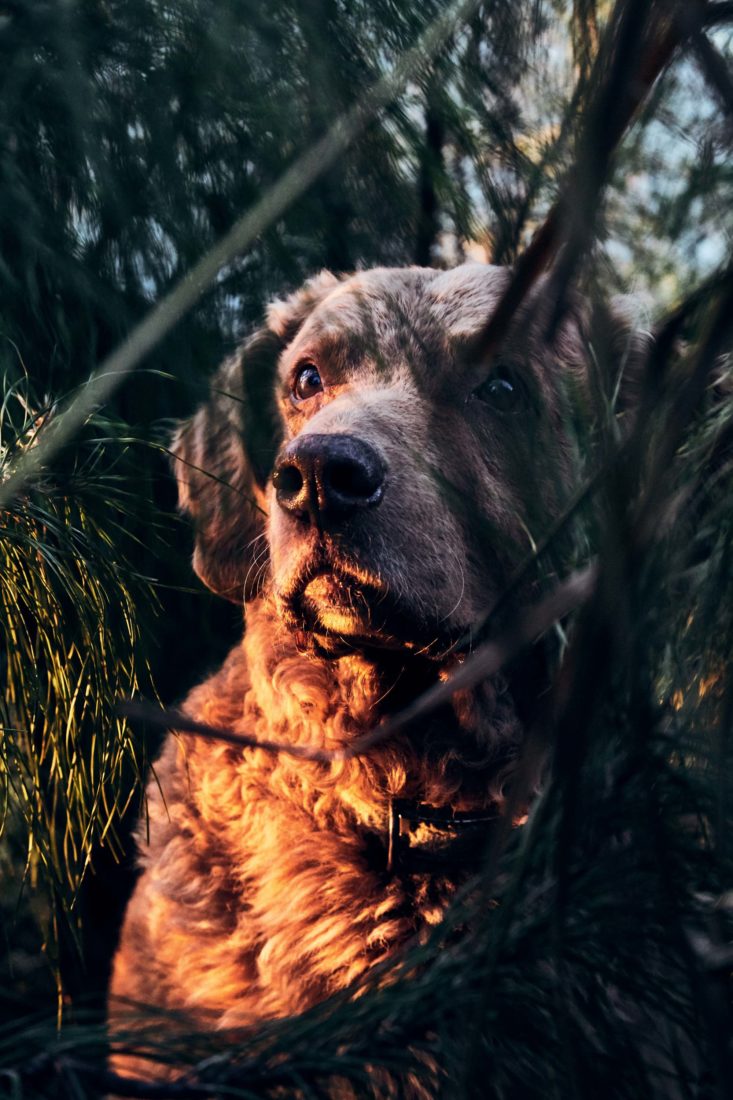
Photo: Peter Frank Edwards
Hunters in the blind.
I thumb through a copy of Saving American Birds, the fabulous biography of T. Gilbert Pearson, a founder and president of the National Association of Audubon Societies, the precursor to the National Audubon Society. Studies of decoy carvers and early writings by naturalists such as Edwin Way Teale line the shelves. For a bird nut and amateur conservation historian, it’s a trove no less compelling than a marsh full of ducks. Andeck joins me in the great room, and ice clinks in bourbon glasses. I read aloud some noteworthy excerpts from the old Pine Island Club shooting records, notations that go back to the 1930s.
November 29, 1932
Limit in one hour and a half. [And this when
limits were fifteen per day.]
January 2, 1933
A dying wind. Birds…but came in at early
afternoon, and the guns sounded like cannon.
December 14, 1936
Shot worse than seems possible.
We talk about the intersection of birding and hunting cultures, and the role a place such as Pine Island Sanctuary, with its sweeping history, can play in helping to bridge divides. While Currituck Sound once brought the nation’s attention to the need for wildlife protection, for waterfowlers today, there’s little distance between duck hunting and conservation. Bird-filled skies inspire awe in hunters and nonhunters alike, and both understand that you have to do right by the land for birds such as black ducks and tundra swans—or marsh wrens and oystercatchers—to remain healthy.
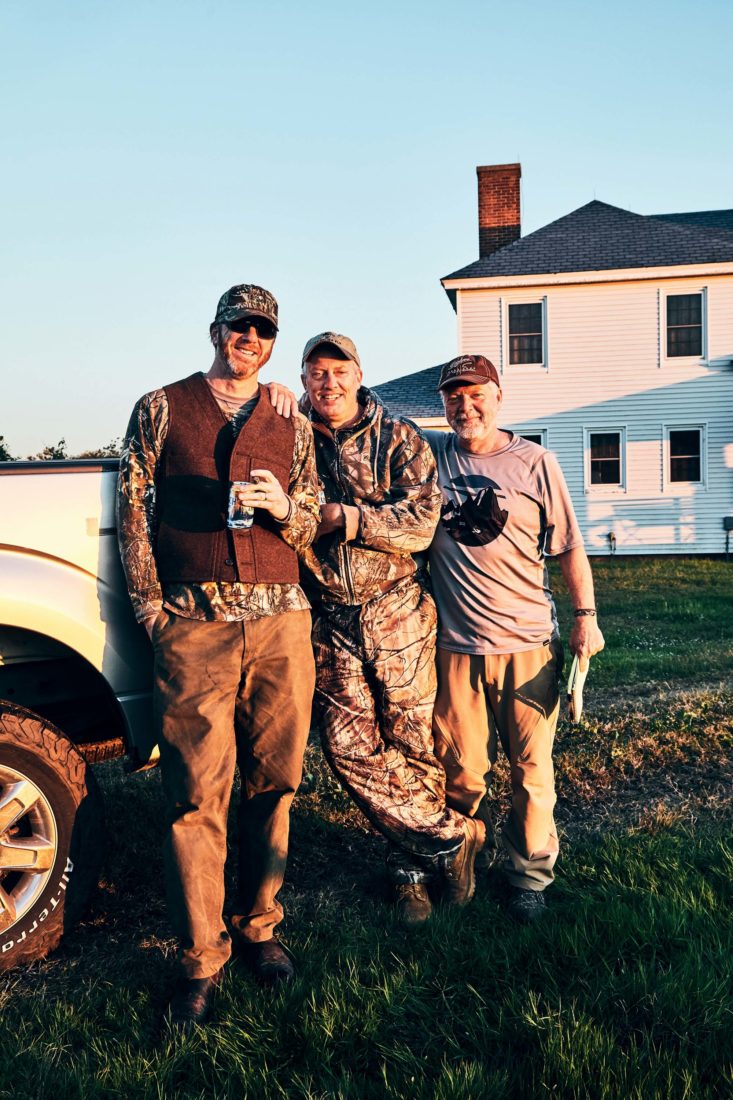
Photo: Peter Frank Edwards
David Knight, Tim Gestwicki, and the author.
“When you think about the way a hunter interacts with the environment, sitting very quietly, very still, being incredibly observant of what is happening around them,” Andeck says, “they are doing the same thing as a passionate birder. In large measure they care about, and think about, and work for the same things. Are there differences? Sure. But there is more that binds them together than keeps them apart.”
My hunting partners the next morning illustrate Pine Island Sanctuary’s collaborative approach to conservation. I share a marsh blind with Tim Gestwicki, CEO of the North Carolina Wildlife Federation, and David Knight, director of the state’s Outdoor Recreation Industry Office. Gestwicki is at Pine Island to talk with Andeck about efforts to reach out to a wider pool of constituents for conservation. Knight is interested in hearing more about the intersection between sporting interests and environmental policy. From our stake blind overlooking a creek channel, I can see the horizon of the coastline, crenellated with the rooftops of shoulder-to-shoulder homes. I can hear the sea. Pine Island Sanctuary is the Outer Banks that used to be, with its stark beauty, its untrammeledness still intact.
I watch black ducks strafe over the marsh in an isosceles triangle of silhouettes in rigid formation. The season for black ducks doesn’t open for another few weeks, so we let them circle in a tightening gyre over the decoys, lower and lower, and as I look for the birds in the glare of early sun, it occurs to me how much the Sanctuary is a divided soul. Great change has marked Currituck Sound over the years. Greater change is coming. Pine Island Sanctuary is shoring up its hold on history while meeting the future—a daunting future—with a full gaze, trying not to blink.


